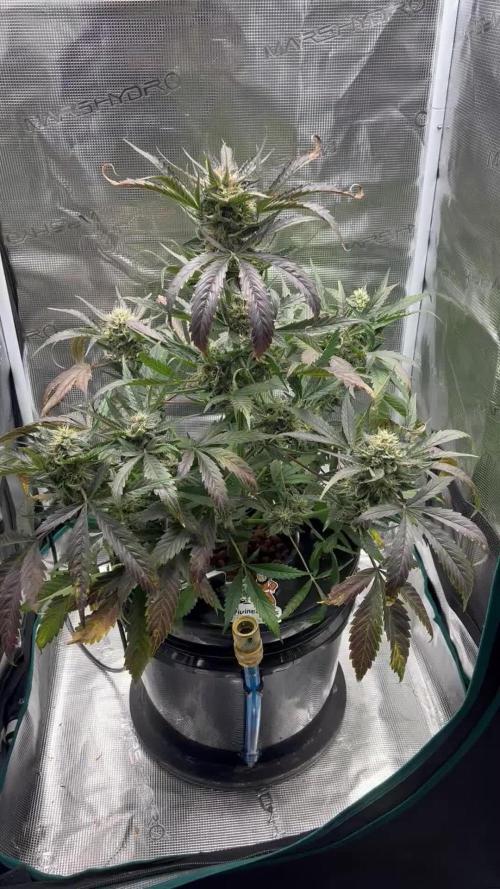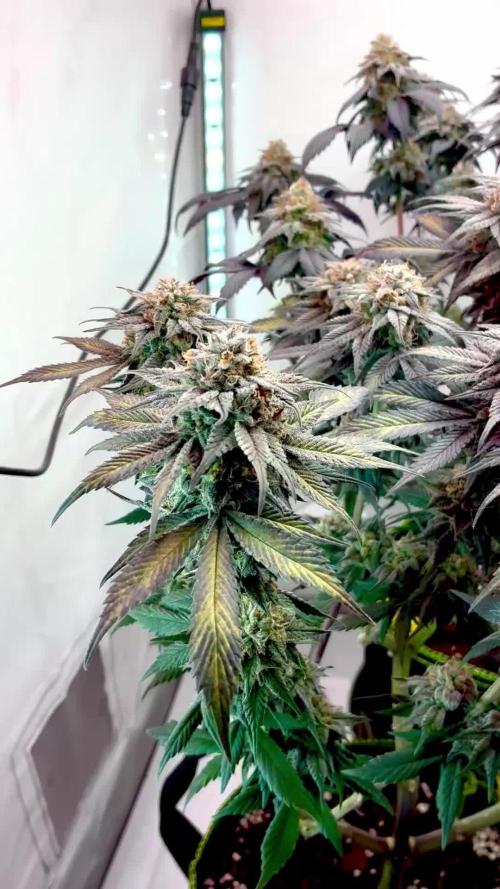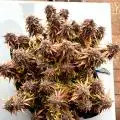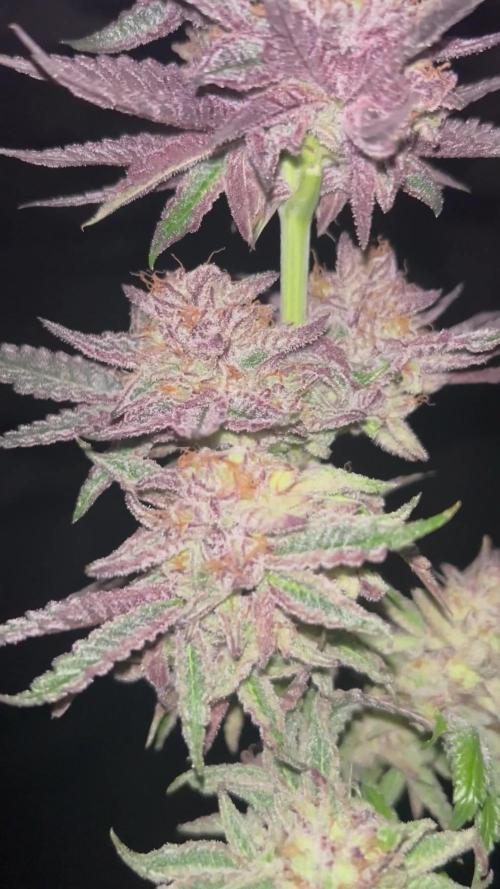The Grow Awards 2026 🏆 

































Likes
Comments
Share


@Hashy
Follow
********************************************
Week 11 mid flower (week 5 flower)
********************************************
Light cycle=12/12
Light Power=160w 67%
Extractor controller settings (during lights on).
High temp= 26c
Temp step=0c
High Rh= 52%
Rh step=0%
Speed max=10
Speed min=3
Extractor controller settings (during lights off).
High temp= 21c
Temp step=0c
High Rh= 56%
Rh step=0%
Speed max=10
Speed min=3
Smart controller settings (during lights on).
Lights on=9.00am
Radiator on= -22.5c
Radiator off=+23.0c
Top fan on=
Smart controller settings (during lights off).
Lights off=9.00pm
Radiator on=-18.5c
Radiator off=+19.0c
Top fan on
VPD aim=0.9-1.4
DLI aim=35-40
EC aim=0.8-1.6
PH aim=6.0-6.5
💧💧💧💧💧💧💧💧💧💧💧💧💧💧💧💧
NPK= 9-18-28
Method= Automatic
Feed=Flower nutes
Neutralise=0.1ml/L
Plagron bloom=4.5ml/L
Plagron Power buds=1ml/L
Green Sensation=1ml/L
Easy Ph Up=0.035ml/L
(1ml=23 drops, each drop is 0.043ml)
Ec=1.6 PH=6.3/6.3
Runs=18
Run times=4mins (L/L each)
Gap times=16 mins
Total runtime=72mins(L/L each)
Total flowrate= ml/min(ml/min each)
Auto start time=10.00am
Auto stop time=15.44pm
💧💧💧💧💧💧💧💧💧💧💧💧💧💧💧💧
********************************************
********************************************
📅15/12/24 Sunday (Day 71)(flower day 31)
📋 removed support from snapped cola as its mended now.
Slight adjustments and defoliation.
💧
Automatic mid bloom nutes
Ph up=0.43ml, 10 drops
Ec=1.6 PH=6.3/6.3
Volume=12L
Volume left=1.5L
Volume used=10.5L(ml/min)
Volume each=5.25L(ml/min)
Runoff.
Total runoff=2.4L
Ec=3.4 PH=/6.2
💧
📅16/12/24 Monday (Day 72)(flower day 32)
📋
📅17/12/24 Tuesday (Day 73)(flower day 33)
📋
📅18/12/24 Wednesday (Day 74)(flower day 34)
📋
💧
Automatic mid bloom nutes
Ph up=0.43ml, 10 drops
Ec=1.6 PH=6.3/6.3
Volume=12L
Volume left=2.5L
Volume used=9.5L(ml/min)
Volume each=4.75L(ml/min)
Runoff.
Total runoff=0.4L
Ec=3.2 PH=/6.4
💧
📅19/12/24 Thursday (Day 75)(flower day 35)
📋
📅20/12/24 Friday (Day 76)(flower day 36)
📋
📅21/12/24 Saturday (Day 77)(flower day 37)
📋 Slight defoliation
H=92cm D=23cm Dli=46 8 ppfd=1080
********************************************
Weekly roundup.
📋 It's been bitter cold outside this week so the radiator has been in use a lot this week using 38.95Kw £9.73
She is loving everything so far, a little behind the other strain in development but not by much, got nice spacing between the flowers and great airflow around her.
Back soon.
Take it easy.
********************************************
Processing
Likes
31
Share


@WeedWacker
Follow
Nov 20, 2019
The plants are doing well. Gave them and the soil in the entire 5 gallon pots a good drenching with a compost tea, kelp, alfalfa, fish hydrysolate, and molasses blend.
I'm also realizing I could be watering these girls a bit more. Being a newby I'm over cautious of over watering. But I'm finding the light airy soil mix I made combined with fabric pots.... the soil dries rather quickly. No signs of under watering, but I think I can water them more.
This week I'll start watering a couple of cups daily and once a week give the whole pot a good drenching to keep the rest of the soil (where the plants haven't grown into yet) damp.✌️
Nov. 22, 2019
Well I think the girls are starting to give off a little scent. Opened the doors to the room and noticed a slight aroma of woodsy dank. Put my nose right up to the plant.... and yup, they starting to smell.
Nov. 23, 2019
Noticed the front row was growing faster and taller than back row. At the start of this week I swapped the rows, moved 2 Zkittlez and 1 Californian Snow to the back row, 2 Californian Snow and 1 Zkittlez to the front row.
Today I started LST'ing the taller plants, 2 Californian Snow and 1 Zkittkez.
I hope the other 3 catch up soon. I want to keep these all close together.
Nov. 24, 2019
I've decided to keep separate diaries here at growdiaries for each of these two strains. Reason is I can focus on journaling the growing characteristics, experiences both good and bad regarding each strain independently. Also after spending time here at growdiaries, I've realized this will make it easier for fellow growers growing or researching the same strains I am to sort through diaries regarding these specific strains when looking for information. I will still update this diary regularly but it will be general updates of the overall grow, environment changes, watering/ feeding schedule, and anything else this grow experiences good and bad without getting into great detail regarding each individual plant. I have provided the links to the strain specific diaries below. Please look them up and follow along. Since this is my first growing evidence ever you never know what kinda crazy shit you'll see.✌️
https://growdiaries.com/diaries/44659-fastbuds-zkittlez-auto-grow-journal-by-weedwacker
https://growdiaries.com/diaries/44676-fastbuds-californian-snow-grow-journal-by-weedwacker
Nov. 25, 2019
Sitting here waiting for my windows 10 top update...I thought it'd update this diary.
Started to LST the 3 tallest plants... earlier I posted the front row was growing faster than the back row. That was Saturday Nov. 23.
I LST'd the other 3 the next day. I'll have more details in the individual diaries... links posted above.
Started watering today 6 cups/ pot. This seems about right as I'm getting very little run off and the bottoms of all the fabric pots are wet.
I found this Hydrofarm soil moisture/ph meter in a box that was with all this equipment I acquired. The electrodes were corroded, after a little sandpaper on them I think it's working pretty well.
That's it for this week. ✌️👌
Likes
2
Share


@AZTERPHUNTER
Follow
trimmed them up little topped at 3 nodes on main and others. Defoliation little by little over time.
Likes
23
Share


@Ctrellis90
Follow
Welcome to week 8 of my Strawberry Cheesecake diary from seedsman!
At this phase in her growth there really isn't much left for me to do but water her and maintain the soil a bit for the next month.
I ended giving her some good homemade sprouted barley and LABS, so I'm sure she's lovin life right now and her flowers are looking amazing!
She smells strong of fruity skunk facts, so thats interesting 😆. I love it. We can see a bunch of trichomes coming in and some of her pistols are turning a very nice neon orange color.
The only thing that concerns me is some spots on her leaves that could possibly be rust, so I gave her a very light foliar spray of baking soda just in case.
I've also started adding quillaja to her water to help with saponin content.
Likes
22
Share


@Still_Smoq
Follow
Week 9, 3-9 October 2025
3-9 Oct - Observed and let the plant grow.
Buds continue to develop and swell as it grows toward maturity. The smell continues to intensify as well. A lot of trichomes have developed and the hairs are just starting to turn brown. Because of the plants smaller size, I don’t have to do a weekly reservoir change, it’s more like every 10 days. She just doesn’t consume as much as a larger plant would.
- 2 Oct changed nutrient solution
- 2 Oct updated feeding schedule
- Using reverse osmosis water with EC/TDS at 0
- Adjusting PH to 6.1 daily using GH up/down
- Nutrient solution EC 2.1 at 72 degrees F
- Light power at 75%, DLI 45 canopy coverage at 18hrs
- Using PYPABL, Air Pump, 400GPH
That is it for this week. Thanks for the look, read and stopping by.
Likes
6
Share


@I_Identify_As_A_Dan
Follow
Week 1 of flower for Space panda by Atlasseed,
Pheno 1 was fed her 2.7g of BioBloom per L of soil, watered that in and flipped it to flower 24hours ago.
As more room opens up in the tent ill spread her out a little more.
Also wont be defoliating unless necessary as I'm trying to bring up the humidity a little.
While Pheno 2 im going to keep in veg for a week or 2 longer as shes a little behind on size.
Likes
2
Share


@lolasher
Follow
Die letzte Woche ist angebrochen.
Viel wurde nicht gemacht. Alle 3 Tage 3l Wasser pro Pflanze.
Likes
24
Share


@eh_eh_eh_buds
Follow
so were almost at harvest, have begun flushing this last week and hopefully will be chopping beginning of next week, then the cure... CAN NOT WAIT TO BUST UP SOME OF THESE NUGS AND PACK THEM IN THE BON 😆
Likes
28
Share


@BudVision
Follow
Hello growers,
I harvested because she had completely consumed everything in her pot, so there was nothing left to wait for. The aroma is sweet and spicy, hard to describe but very pleasant. The bud is dense and beautifully colored.
Peace and happy growing! ✌️
Likes
12
Share


@420DeepGrow
Follow
Gracias al equipo de AnesiaSeeds, Marshydro, XpertNutrients y Trolmaster sin ellos esto no sería posible.
💐🍁 Coco Jambo:
Con una composición genética 60% Sativa y 40% Indica, Coco Jambo es tu billete dorado a un verano sin fin, ofreciéndote una escapada a un mundo donde el sol nunca se pone en tu felicidad.
Con unos niveles de THC que oscilan entre un relajante 30% y un estimulante 34%, Coco Jambo es un faro de euforia que guía a sus usuarios en un viaje a través de olas de serenidad y vibrante alegría. Su aroma es una celebración de los sentidos; imagina el momento de euforia al abrir un coco y descubrir que rebosa de las frutas tropicales más suculentas.
🌻🚀 Consigue aqui tus semillas:
https://anesiaseeds.com/es/product/coco-jambo/
💡TS-3000 + TS-1000: se usaran dos de las lámparas de la serie TS de Marshydro, para cubrir todas las necesidades de las plantas durante el ciclo de cultivo, uso las dos lámparas en floracion para llegar a toda la carpa de 1.50 x 1.50 x 1.80.
https://marshydro.eu/products/mars-hydro-ts-3000-led-grow-light/
🏠 : Marshydro 1.50 x 1.50 x 1.80, carpa 100% estanca con ventanas laterales para llegar a todos los lugares durante el grow
https://marshydro.eu/products/diy-150x150x200cm-grow-tent-kit
🌬️💨 Marshydro 6inch + filtro carbon para evitar olores indeseables.
https://marshydro.eu/products/ifresh-smart-6inch-filter-kits/
🍣🍦🌴 Xpert Nutrients es una empresa especializada en la producción y comercialización de fertilizantes líquidos y tierras, que garantizan excelentes cosechas y un crecimiento activo para sus plantas durante todas las fases de cultivo.
Consigue aqui tus Nutrientes:
https://xpertnutrients.com/es/shop/
💻 Trolmaster Tent-X TCS-1 como controlador de luz, optimiza tu cultivo con la última tecnología del mercado, desde donde puedes controlar todos los parametros.
https://www.trolmaster.com/Products/Details/TCS-1
📆 Semana 10:
Última semana antes del corte final, los cogollos están bien prensados y cargados de resina de un color muy lechoso, solo falta que se tornen algunos tricomas más en ámbar.
MarsHydro y XpertNutrients han hecho de nuevo un gran trabajo 💪😍
Likes
15
Share


@Oetelando
Follow
One of the Zakes ( topped one)get Harvest today.
In 2 Weeks i can say more but she looked very very nice
Eine Zake (Getopped) wurde als 1. geerntet da sie den Trichome Chek bestand.
Likes
154
Share


@Tropicannibis_Todd
Follow
💩Holy Crap Growmies We Are Back💩
Code Name FBT2311
Well growmies we are at 56 days in and everything is going as good as it can 👌
👉Shes been doing really good , lots of buds and some nice colors and smells 👌💪she's the top of of the lot 💪
Lights being readjusted and chart updated .........👍Even with early major issues due to the soil/medium she's come a long way 👈
👉I used NutriNPK for nutrients for my grows and welcome anyone to give them a try .👈
👉 www.nutrinpk.com 👈
NutriNPK Cal MAG 14-0-14
NutriNPK Grow 28-14-14
NutriNPK Bloom 8-20-30
NutriNPK Bloom Booster 0-52-34
I GOT MULTIPLE DIARIES ON THE GO 😱 please check them out 😎
👉THANKS FOR TAKING THE TIME TO GO OVER MY DIARIES 👈
Likes
4
Share


@weed_gastro
Follow
day 42: LOTTA leaves, had to defoliate 2-3 times.
they started to show their first pistils a couple days before the Ayahuascas, hope I can do a harvest before May,(the Peyotes) but it seems really tricky..unfortunately I need to leave them for a week in April. I'm pretty scared to leave them alone at the end of flowering...
Day 43: do you think the leaves on 2 plants might be too dark green? Thanks!
day 46: defoliating
Likes
4
Share


@SakuraAsa
Follow
11/21
Mother#1,2 D85 13Week
#1Clone☓2 D63 SD42
#2Clone☓4 D53 SD32
#3Clone☓4 D52 SD28
Grow 1ml / Bloom 3ml/l Max 1ml/l = 1l
#5 Clone☓12
Likes
15
Share


@Korinthius
Follow
So this plant is phenomenal with her recovery abilities. At this point, she recovered from her previous topping only 7 days ago, and grown the final 2 inches I was waiting for. As of 4/26, she is now on 12/12. Additional nutrients will be added to her for her flower period.
Time-lapse again had an error, this time, I swear, it was not me. Looks like the camera and server stopped communicating until both were restarted.
So as a reference, this plant is now 10 weeks from seed. She has been topped 3 times for a total of 8 crowns. I expect harvest to be approximately 10 weeks from now. But we all know how far expectations can take us.
Likes
3
Share


@mastering420
Follow
👇👇👇👇👇👇
It's been raining a lot here in Thailand these days. The plant is staying indoors under LED lighting most of the time. Humidity peaks at 90%, and I'm watering once a day.
Gradually increased EC from 400 to 800 (200 to 400 PPM).
Plants are hungry for extra EC.
Started adding silica after the second node appeared.
Likes
14
Share


@HELLFIRE424
Follow
End of week 6, came across a bad nute burn in my opinion. The grape pupil looks like it has a cal-mag problem from looking up the damaged burned leaves online. Also still having a height problem but gonna keep pushing forward due to not having nothing to rise my leds.
























